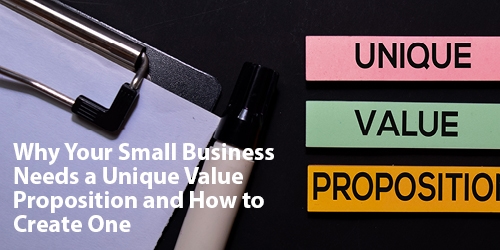In today’s multi-channel online environment, consumers are faced with more choices than ever before. As a small business facing so much competition, you need to stand out. This is where a unique value proposition (UVP) comes into play.
The UVP is often the first thing consumers read about your company, so it’s important to get it right. It can make the difference between a potential customer choosing you or the competition. In this post, we’ll look at what a UVP is, why you need one, and how to create an effective one for your business.
What is a Unique Value Proposition (UVP)?
Sometimes referred to as a unique selling proposition (USP), a UVP is a clear statement that explains four things:
1. Who your target customer is.
2. What your business is offering.
3. How potential customers will benefit from your offer.
4. Why you are different or better than your competitors.
An effective UVP is not a slogan; it’s a concise summary of how your product or service benefits customers and why prospects should choose to do business with you. It’s normally displayed on a website’s homepage as a headline or leading statement, and is often accompanied by an image, video, or graphic.
Why Your Small Business Needs a Strong UVP
Your value proposition is key to giving a good first impression of your company and holding the attention of website visitors. A strong UVP will quickly highlight the value of your offer and set you apart from the competition. When you get it right, it can improve on-page conversions, inspire visitors to explore more of your website, and move prospects closer to a purchase decision.
How to Create an Effective UVP
Before you create your UVP, you need to define the answers to some fundamental questions. Try to answer the following four questions as concisely as possible with your unique business in mind:
1. Who is Your Target Customer?
Exactly who are you trying to sell your products or services to? The answer is not as straightforward as some people think. You need to answer the following questions:
• Ideally, who would you like to reach?
• What type of person frequently uses your product or service?
• What common problems or challenges do they face?
• What motivated them to search for your product or service?
Use your answers to more clearly define your ideal customer persona.
2. What Product or Service Do You Offer?
Focus on the core purpose of your product or service. Try not to go into too much detail; simply focus on what problem or need you’re addressing and highlight how your product or service solves the problem or fulfills the need. Use clear, descriptive language that is easy to understand and engaging.
3. How Do Customers Benefit from Your Offer?
Pinpoint exactly how customers benefit from your product or service by referring to the problem or need you’re addressing. This needs to be developed into a clear statement that will resonate with your target customer. Use language typically used by your target customer when they’re looking for the solutions you offer. Some key benefits might include:
• Lower price.
• Quicker results.
• Lasting quality.
• Faster delivery.
• A more personalized service.
Focus on the most impressive and interesting benefits that you can think of.
4. Why Are You Different from the Competition?
It’s crucial that your UVP includes something that sets you apart from the competition. There are probably many other companies offering something similar to consumers, so you need to convince readers that you’re the right choice. It might be that the most compelling benefit you offer customers is what differentiates you from the competition.
A simple way to find out what makes you different is to check out your competitors. Look at the wording they use on their website. Is there something missing that you can take advantage of? What do you do better than them?
Refine Your UVP
The above preparation is a great starting point. Once you’ve written down the answers to these questions, you can begin to rework your statement until you have a value proposition that is a single, effective sentence. Remember:
• Keep it short and sweet and avoid jargon. Use language that your customers use.
• Highlight what your target customer needs before explaining what you offer.
• Try to make it memorable. Use unique words and emotive language.
• Make it personal by mentioning your specific target audience.
Where to Display Your UVP
The most important location to display your UVP is on your website’s homepage, above the fold. To make sure it’s one of the first things visitors notice, use a larger font and leave enough space around it so that viewers don’t get distracted by other page elements.
You should also include your UVP on other channels such as your social media profiles and within email newsletters. Other prime locations include product pages and category pages.
Taking It Further
After you’ve written your UVP, it’s a good idea to test it. Reach out to friends, family, or social media followers to get feedback. Use the responses to refine your UVP and make it as clear and compelling as possible.
If your small business lacks a strong unique value proposition, it’s time to use these guidelines to create one for your business. When you get it right, you’re more likely to engage website visitors, stand out from the competition, and push potential customers closer to a purchase decision. Your UVP may only be a few words, but these crucial words can drive sales for years to come.
If you have any questions, our team would be more than happy to help. Call us today at (484) 893-4055.








